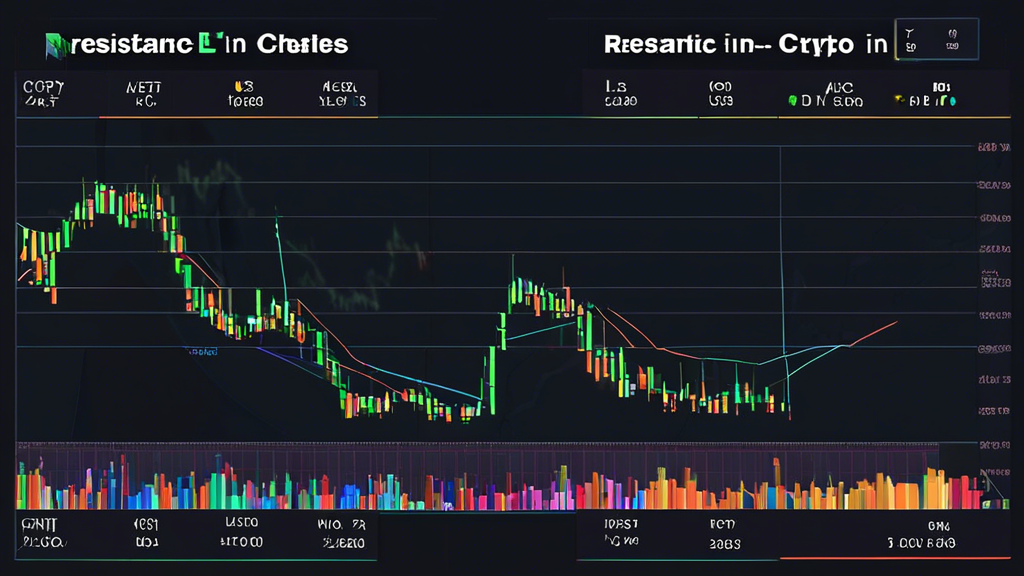Understanding Margin Trading in Crypto: Risks and Rewards What is Margin Trading in Crypto? A…
Mastering Crypto Trading: Understanding Support and Resistance

In the rapidly evolving world of cryptocurrency, mastering the nuances of trading can mean the difference between profit and loss. As digital assets gain traction among investors, understanding key concepts such as support and resistance becomes crucial for anyone looking to navigate these turbulent markets. Support and resistance are fundamental tools in technical analysis, offering insights into potential price movements and trends. These levels not only highlight where the price is likely to find buying or selling pressure, but they also reflect the psychological barriers that traders encounter. In this article, we’ll delve into the importance of support and resistance in crypto trading strategies, explore various types of support and resistance levels, and equip you with techniques to effectively identify and apply these critical concepts in your trading endeavors. By grasping these foundational elements, you’ll be better positioned to make informed trading decisions and enhance your overall trading performance in the dynamic world of crypto. Whether you are a novice or an experienced trader, a clear understanding of support and resistance will provide you with a strategic advantage in your crypto trading journey.
Introduction to Crypto Trading and Its Importance
Crypto trading has emerged as one of the most dynamic and rapidly growing sectors in financial markets. With the adoption of digital currencies like Bitcoin, Ethereum, and countless altcoins, crypto trading has captured the interest of both new and experienced investors. According to a report by Statista, over 300 million people worldwide are now involved in cryptocurrency trading. This remarkable growth underscores the significance of mastering trading concepts, particularly support and resistance, which are critical for navigating the often volatile crypto landscape.
To excel in crypto trading, one must grasp fundamental concepts that dictate price movements. Among these are support and resistance levels. Support refers to a price point where a cryptocurrency tends to stop falling and starts to rebound due to increased buying interest. On the other hand, resistance is a level where a cryptocurrency typically stops rising and begins to decline due to increased selling pressure. Understanding these key concepts is essential for developing effective trading strategies.
Key Concepts in Crypto Trading
- Volatility: Crypto markets are known for their price fluctuations, often leading to heightened risks and opportunities.
- Liquidity: The liquidity of a cryptocurrency impacts how easily it can be bought or sold without affecting its price significantly.
- Technical Analysis: Analyzing price charts and trading volumes to predict future price movements.
Mastering support and resistance is particularly crucial as these levels create a framework for traders to make informed decisions. By identifying where prices are likely to bounce or reverse, traders can set entry and exit points more strategically.
Importance of Support and Resistance in Trading Strategies
Understanding support and resistance strengthens a trader’s ability to make sound decisions and mitigate risks. Here are several reasons why these concepts are integral to successful crypto trading:
- Market Insights: Support and resistance levels provide insights into market psychology, reflecting where traders are likely to buy or sell based on their emotions and expectations.
- Trade Timing: Recognizing when a cryptocurrency is near support or resistance helps traders decide the optimal times to enter or exit a trade.
- Risk Management: Traders can set stop-loss orders around support levels to limit potential losses, fostering a disciplined trading approach.
- Profit Maximization: By identifying resistance levels, traders can set take-profit orders to secure gains before a potential price decline.
Further Exploration
For traders interested in deepening their understanding of these fundamental concepts, numerous resources are available online. Here are a few recommended links:
- Investopedia – Support Levels
- Investopedia – Resistance Levels
- Coindesk – Guide to Support and Resistance in Crypto Trading
As crypto trading continues to gain traction and evolve, mastering the nuances of support and resistance will empower traders to navigate the complexities of this market confidently. With the potential for significant returns, understanding these concepts is a vital step toward achieving success in the ever-changing world of cryptocurrency.

Understanding Support and Resistance Levels
In the realm of crypto trading, understanding support and resistance levels is crucial for making informed trading decisions. These levels serve as critical indicators of market momentum and can significantly influence trader behavior. Let’s break down these concepts further.
Definition of Support and Resistance
- Support: This is a price level where a declining market tends to halt and reverse due to an influx of buying interest. It acts as a floor, preventing the price from falling further.
- Resistance: Conversely, resistance is a price level where an advancing market typically encounters selling pressure, preventing the price from rising further. It acts as a ceiling, making it hard for prices to move past it.
Types of Support and Resistance Levels
Support and resistance levels can be categorized into various types:
| Type | Description |
|---|---|
| Horizontal Support and Resistance | Price levels that remain constant over time, often identified at historical highs or lows. |
| Trendline Support and Resistance | Diagonal lines drawn on price charts that show upward (support) or downward (resistance) trends. |
Market Psychology and Trader Behavior
The concepts of support and resistance are not just numerical values; they are heavily influenced by market psychology. Understanding how these levels affect trader behavior can provide deeper insights into market movements:
- Buying Pressure at Support: Traders often see support levels as opportune buying points, leading to increased purchasing activity.
- Selling Pressure at Resistance: Similarly, resistance levels signal selling opportunities, causing traders to sell or short-sell their positions.
- Emotional Reactions: Traders’ perceptions of support and resistance can lead to emotional reactions, causing price fluctuations as traders act on fears and hopes.
Why Understanding Support and Resistance is Vital
Identifying support and resistance levels is vital for several reasons:
- They provide entry and exit points for trading strategies.
- They help in determining stop-loss placement, minimizing risk exposure.
- They offer insights into potential market reversals, providing traders with a clearer market outlook.
Understanding these levels helps traders navigate crypto volatility effectively, making it easier to go with the flow of the market rather than against it.
Real-World Application
Numerous trading platforms and educational resources illustrate the significance of support and resistance in real-world scenarios. For example:
- CoinDesk: Provides comprehensive market analysis that highlights key support and resistance levels.
- TradingView: Offers tools and charting capabilities to visualize support and resistance directly in price action.
By studying recent price charts, traders can identify how historical support and resistance levels correlate with current trading conditions.
Conclusion
Mastering the concept of support and resistance in crypto trading not only enhances a trader’s skill set but also builds confidence in making strategic decisions amidst market uncertainties. A well-rounded understanding of these psychological price points sets the groundwork for a successful trading strategy.

Identifying Support and Resistance in Crypto Markets
In crypto trading, accurately identifying support and resistance levels is essential for making informed decisions. Here, we’ll explore various techniques and tools that traders can use to pinpoint these critical levels, along with real-world examples to illustrate their effectiveness.
Techniques for Identifying Support and Resistance Levels
- Historical Price Levels: Analyze historical price data to identify points where the price has frequently reversed direction. These levels often serve as strong support or resistance.
- Trend Analysis: Determine the direction of the market trend (uptrend, downtrend, or sideways) and identify potential support (in uptrends) or resistance (in downtrends) based on prior price action.
- Volume Profile: Observe trading volumes at specific price levels. High volume at certain levels can indicate stronger support or resistance due to increased buying or selling interest.
- Chart Patterns: Look for standard chart patterns like double tops, double bottoms, head and shoulders, or triangles that suggest where price reversals may occur.
Tools and Indicators for Pinpointing Support and Resistance
Several technical analysis tools can assist traders in identifying support and resistance levels effectively:
| Tool/Indicator | Description | How to Use |
|---|---|---|
| Moving Averages | Averages of past prices that smooth out price data and highlight potential reversal areas. | Use short-term and long-term moving averages to identify dynamic support and resistance; for instance, look for bounces from the 50-day or 200-day moving averages. |
| Fibonacci Retracements | A tool based on the Fibonacci sequence used to predict potential retracement levels in a price movement. | Draw Fibonacci retracement levels from a significant price peak to trough (or vice versa) to find areas of support and resistance that traders may react to. |
| Bollinger Bands | A volatility indicator that consists of a middle band (moving average) and two outer bands (standard deviations). | Price often reacts at the upper and lower Bollinger Bands, serving as dynamic levels of resistance and support. |
Real-World Examples of Support and Resistance in Recent Crypto Trading Patterns
Understanding concepts through real-world examples can clarify how to leverage support and resistance in crypto trading:
- Bitcoin (BTC) Price Action: In late 2022, Bitcoin approached a significant support level around $15,500 multiple times, indicating a strong buying interest. After several attempts, BTC eventually bounced back, signaling the effectiveness of this support level.
- Ethereum (ETH) Collapse and Recovery: Following a massive sell-off, Ethereum retraced towards a resistance level at $4,000 in early 2021, upon which the price failed to break. This resulted in a reversal, where traders could have effectively used this level to take profits or set stop-losses.
- Litecoin (LTC) Consolidation: In 2023, Litecoin formed a range between $80 and $100, with $80 acting as robust support and $100 serving as resistance. Traders observing this pattern might have executed trades within this range for short-term gains.
Conclusion
Identifying support and resistance levels is a foundational skill in crypto trading. By employing various techniques and utilizing specific tools, traders can gain insights into market behavior and make more informed trading decisions. As the crypto market evolves, continually revisiting these techniques will be crucial for adapting strategies to changing market conditions.
For further reading and a deeper understanding of market analysis in crypto trading, you can explore resources like Investopedia’s Support and Resistance Guides or The Nation’s Analysis of Bitcoin Trading Patterns.

Applying Support and Resistance in Crypto Trading Strategies
Incorporating Support and Resistance into Trading Strategies
To effectively apply support and resistance in your crypto trading strategies, consider the following methods:
- Trade Breakouts: When the price moves above a resistance level or below a support level, it indicates a potential breakout. Traders can enter a position when this occurs, anticipating continued movement in the direction of the breakout.
- Reversal Trades: If the price approaches a defined support or resistance level and shows signs of reversing (e.g., candlestick patterns), this is an opportunity to enter a trade in the opposite direction.
- Trend Following: Use support and resistance to identify the overall trend. In a bullish market, consider buying near support levels, and in a bearish market, consider selling near resistance levels.
Stop-Loss and Take-Profit Levels
Using support and resistance levels can greatly enhance your risk management strategy through the placement of stop-loss and take-profit orders.
| Order Type | Placement Strategy | Rationale |
|---|---|---|
| Stop-Loss Order | Place below a support level for long positions. | If the price breaks through support, it may indicate a further decline. |
| Take-Profit Order | Set just below a resistance level for long positions. | To secure profits before a potential reversal at resistance. |
| Stop-Loss Order | Place above a resistance level for short positions. | If the price exceeds resistance, it could continue to rally. |
| Take-Profit Order | Set just above a resistance level for short positions. | To capitalize on price movement before a reversal occurs. |
Common Pitfalls to Avoid
While support and resistance are powerful tools in crypto trading, there are pitfalls to be mindful of:
- Ignoring Market Context: Always consider market conditions. Support and resistance can change in volatile markets. Too rigid an application may lead to losses.
- Overreliance on Historical Levels: Just because a level has acted as support or resistance in the past doesn’t guarantee it will do so in the future. Be prepared for false breaks.
- Neglecting to Use Additional Confirmation: Support and resistance should not be used in isolation. Always combine with other indicators (e.g., MACD, RSI) to strengthen your trading decisions.
- Failing to Adapt: Market dynamics in crypto can change quickly. Regularly update your analysis and be open to adjusting your strategies.
Real-World Application and Examples
A sound understanding of applying support and resistance in crypto trading can be illustrated with a few real-world examples:
– **Example 1: Bitcoin (BTC):** In August 2021, Bitcoin faced resistance around the $45,000 mark. Many traders noted this level as a key resistance point. Those looking to short the market placed their orders near this level, resulting in a significant price drop after a failed breakout.
– **Example 2: Ethereum (ETH):** Ethereum demonstrated a strong support level near $1,750. Following a series of tests at this level without breaking down, many traders recognized this as a critical support area, leading to a bullish rebound for profit-taking opportunities.
For further insights on trading strategies that utilize support and resistance, consider exploring resources such as Investopedia or TradingView, which provide comprehensive guides and tools.
Conclusion
Mastering the use of support and resistance in your trading strategy is paramount to becoming a successful crypto trader. By integrating these concepts effectively, setting appropriate stop-loss and take-profit orders, avoiding common mistakes, and learning from real-world examples, you can enhance your decision-making process in the ever-evolving crypto markets.
In conclusion, mastering the concepts of support and resistance is essential for any crypto trader looking to enhance their trading strategies and potential success in the highly volatile cryptocurrency markets. Understanding these fundamental levels allows traders to make informed decisions based on market psychology and price behavior rather than emotions.
To effectively identify support and resistance levels, traders should employ various technical analysis techniques and tools. Moving averages and Fibonacci retracement levels are just a few of the indicators that can provide valuable insights into potential price action. By studying historical price patterns, traders can gain a clearer perspective on where these critical levels may lie and how they may impact future trading scenarios.
Incorporating support and resistance into trading strategies not only enables better decision-making but also enhances risk management. Setting stop-loss orders just below support levels and take-profit targets near resistance can help traders safeguard their investments while maximizing potential gains. However, it’s essential to recognize the common pitfalls associated with relying solely on these levels, such as false breakouts and market noise, which may lead to premature trading actions or significant losses.
Ultimately, the journey to becoming a proficient crypto trader involves continuous learning and adaptation to changing market conditions. By diligently analyzing support and resistance levels and integrating them into a comprehensive trading strategy, traders can navigate the complexities of the crypto markets with greater confidence and precision. For those looking to delve deeper into crypto trading strategies, leveraging online resources, community forums, and educational platforms can provide additional insights and enhance practical understanding.





